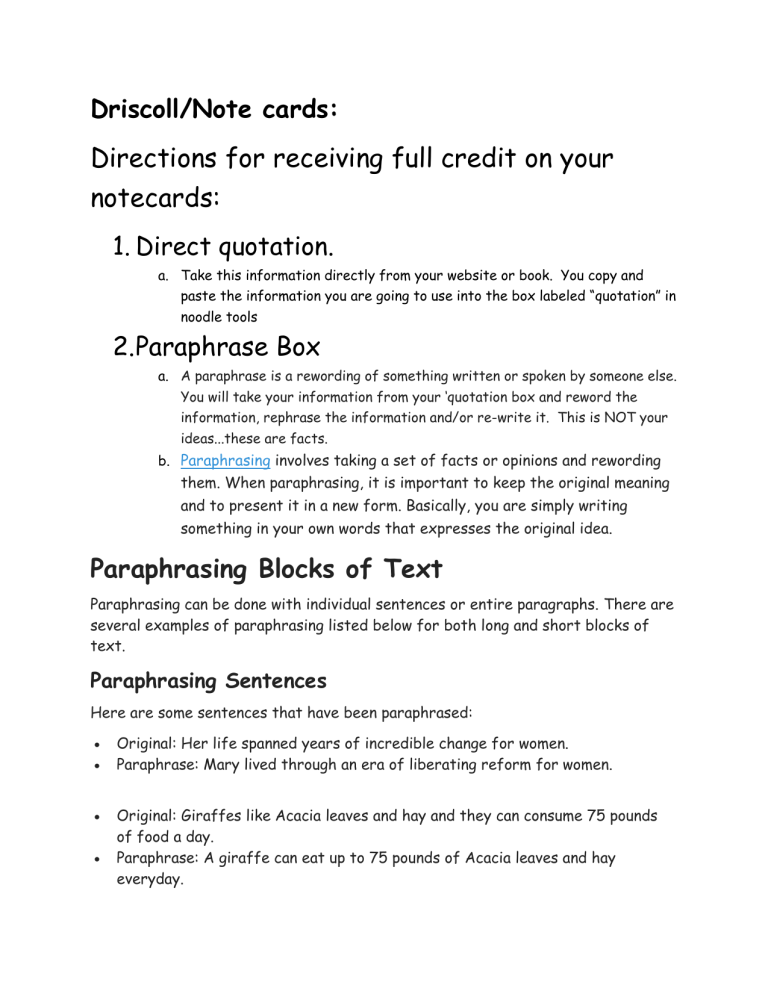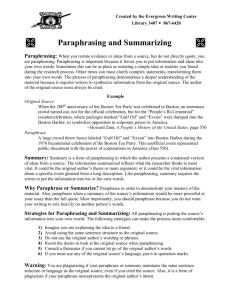Notecards

Driscoll/Note cards:
Directions for receiving full credit on your notecards:
1.
Direct quotation.
a.
Take this information directly from your website or book. You copy and paste the information you are going to use into the box labeled “quotation” in noodle tools
2.
Paraphrase Box
a.
A paraphrase is a rewording of something written or spoken by someone else.
You will take your information from your ‘quotation box and reword the information, rephrase the information and/or re-write it. This is NOT your ideas...these are facts.
b.
Paraphrasing involves taking a set of facts or opinions and rewording them. When paraphrasing, it is important to keep the original meaning and to present it in a new form. Basically, you are simply writing something in your own words that expresses the original idea.
Paraphrasing Blocks of Text
Paraphrasing can be done with individual sentences or entire paragraphs. There are several examples of paraphrasing listed below for both long and short blocks of text.
Paraphrasing Sentences
Here are some sentences that have been paraphrased:
Original: Her life spanned years of incredible change for women.
Paraphrase: Mary lived through an era of liberating reform for women.
Original: Giraffes like Acacia leaves and hay and they can consume 75 pounds of food a day.
Paraphrase: A giraffe can eat up to 75 pounds of Acacia leaves and hay everyday.
Original: Any trip to Italy should include a visit to Tuscany to sample their exquisite wines.
Paraphrase: Be sure to include a Tuscan wine-tasting experience when visiting
Italy.
Paraphrasing Paragraphs
Duke's online website provides many examples of paraphrasing in order to help students understand the difference between paraphrasing and plagiarism.
Here is an example of paraphrasing of a longer passage taken from the Duke website.
Original Passage:
In The Sopranos, the mob is besieged as much by inner infidelity as it is by the federal government. Early in the series, the greatest threat to Tony's Family is his own biological family. One of his closest associates turns witness for the FBI, his mother colludes with his uncle to contract a hit on Tony, and his kids click through
Web sites that track the federal crackdown in Tony's gangland.
Paraphrased Passage:
In the first season of The Sopranos, Tony Soprano’s mobster activities are more threatened by members of his biological family than by agents of the federal government. This familial betrayal is multi-pronged. Tony’s closest friend and associate is an FBI informant, his mother and uncle are conspiring to have him killed, and his children are surfing the Web for information about his activities.
The main point of this passage is that problems within the family are as bad as or even worse than problems caused by the federal government. Details about this betrayal include one family member turning informant, a hit being put out on Tony by family members, and Tony’s kids tracking his activities.
Here is a summary of some of the changes made during the paraphrasing process:
Early in the series = first season
More threatened = greatest threat
Closest friend and associate = one family member
His mother colludes with his uncle = his mother and uncle are conspiring
His kids click through Web sites = his children are surfing the Web
Avoiding Plagiarism
There is a fine line between plagiarism and paraphrasing. If the wording of the paraphrase is too close to the wording of the original content, then it is plagiarism.
The main ideas need to come through, but the wording has to be your own.
To use another person’s writing in your own can be accomplished with quotes and citations. A quote will need to be the exact wording and the author and source will need to be identified.
Paraphrasing usually makes the passage shorter than the original. Another option is to use a summary that is much shorter than the original and is an overview of the main points.
3.
Fill out “My Ideas Box”
a.
This information is important because....
4.
Link your notecard to a source
5.
Pile and Label Your Notecards
a.
Background (1-3) b.
Pro’s (1-3) c.
Counterclaims (1-3)




